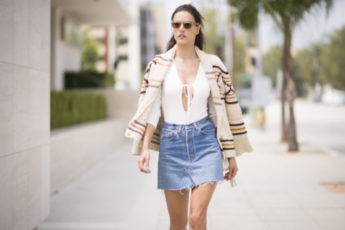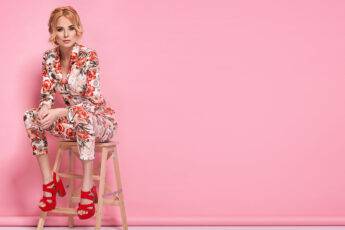5 Tips for Finding Beautiful and Sustainable Fashion

By Andrea Bertinetti
Sustainability is clearly on our minds. Yet few of us will be keen on compromising on our love for gorgeous, elegant clothes. The good news is that garments can be sustainably made and beautiful, as long as you know how to shop.
It’s often just a matter of changing your perspective a little. Here are five good habits to get into. They’ll help you shop for exquisite clothing in a much more sustainable way.
1. Put your shopping through the “30 wears” test.
Do you know the average lifespan of a garment? PLATE, an organization dedicated to studying product lifespans and their impact on the environment, has found that while many garments have several years of use, others have far less. Around 8% of the clothing we own is never used at all, and a further 12% is only worn once or twice.
This means that one in five garments in the average wardrobe is barely or never used. What kinds of garments go unused? Research tells us that occasion wear may only be worn a few times. Other culprits are often “fast fashion.” These are low-cost items that follow a trend that quickly passes. Finally, gifted garments are often not worn at all, particularly those that are offered as promotional freebies.
Unused and barely used garments are an enormous headache for the planet. Every piece makes an environmental footprint. There is a huge carbon emission problem related to both manufacturing and shipping. The clothing industry is a leading cause of water pollution; what’s more, there are many other issues related to landfill disposal and the relatively small amount of clothing being recycled.
To avoid contributing to these problems, ask yourself the all-important question: Can I see myself wearing this at least 30 times or until it eventually wears out? If the answer is no, don’t consider buying it.
Want to buy a gift for a fashion-loving friend or family member? Then it’s safer to purchase gift vouchers so that your loved one can pick out something that will pass their own “30 wears” test.
2. Focus your search on natural fabrics.
The type of fabric makes a big difference to the environmental impact of a garment. For example, for every kg of polyester clothing, 21kg of carbon is produced, around the same as an 85km car journey.
In comparison, a kg of linen creates 15kg of carbon. Man-made fabrics also have a negative impact on our oceans. When they are laundered, tiny plastic microfibers are released into the water, which eventually find their way into our oceans, damaging marine life and delicate ecosystems. These fibers from synthetic clothing make 35% of the plastic polluting our oceans.
There are some beautiful collections that showcase the beauty of natural fabrics, such as Scarlett Poppies’ Sunstone collection.
3. Invest in high quality, timeless pieces.
There are a multitude of reasons to always choose quality over quantity. For a start, premium garments make use of better quality fabrics and are made with higher standards of design, tailoring and craftsmanship.
These differences mean that premium clothing tends to fit better, look better and, most importantly, last better. By buying into timeless looks, you’ll feel the urge to replace clothing less often. Instead, you can look forward to enjoying and feeling confident in the pieces in your wardrobe until they eventually and inevitably wear out.
Not sure how to buy quality garments online?
So many more of us are shopping for clothes online right now. This is partly a result of the pandemic, but also down to convenience and time considerations. One of the reservations shoppers have about buying clothes online is checking quality when you cannot see, feel or try on the garment until you have made your purchase.
Price tags can tell you a little about quality, but not necessarily the whole story. A recommendation would be to tap into social media accounts and online reviews. What are previous customers saying? Is this a brand you’ve seen recommended by an influencer you admire? Finally, don’t forget that online returns have become so much easier to do in recent times, so there is no chance of having to keep any disappointments.
Once your clothes arrive, check the quality of the fabric and workmanship. For example, check the seams (stitching should be tight and there shouldn’t be gaps) and make sure that patterns match up across seams. Embellishments should also be tightly sewn, and hems well finished.
4. Check out a brand’s sustainability credentials.
Unfortunately, some brands prioritize sustainability more than others, even amongst premium clothing companies. You can usually get a good idea how committed fashion brands are by looking at their website and their About page and checking their social media presence.
Transparency is crucial. Before you buy, try to build up an understanding of the brand’s production process. For example, who does the company collaborate with to produce their garments? Are they committed to using organic, certified fabrics? Do they take steps to reduce or minimize transportation? This is a little time-consuming, but well worth the effort.
5. Get smart on sustainable shopping habits.
Knowledge is power, and the more you know about fashion and sustainability, the more empowered you’ll be to make great choices that are planet-friendly from this moment on. This article has covered the basics, but there is plenty of further reading if you want to delve deeper.
The London College of Fashion currently offers some excellent resources, including a short online course. The Council for Fashion Designers of America also has useful and comprehensive guides to the sustainability credentials of virtually every fabric. Finally, try an online fashion footprint quiz. This will help open your eyes to how your current shopping habits may have been impacting the planet and how to move forward from here.
AUTHOR BIO
Andrea Bertinetti is the Marketing Manager at Scarlett Poppies, a vivacious Dubai-based resort and beachwear brand that offers edgy, easy-breezy and effortlessly cool pieces designed by a cultural melting pot of designers. Influenced by tribal trends with a touch of Scandinavian flair, the brand’s beachwear styles are always ethereal and minimalistic.
Share via:





Leave a Comment